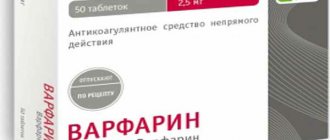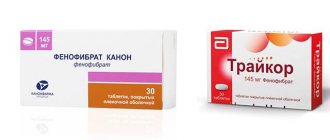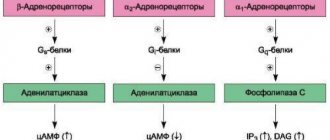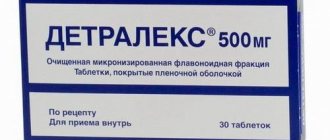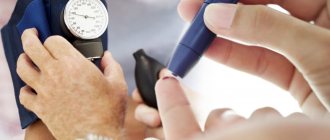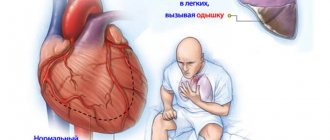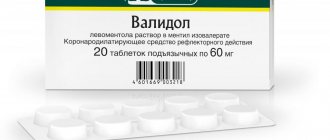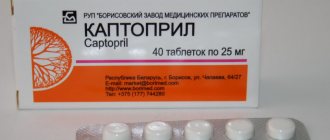Vascular pathologies are represented by a large group of diseases. According to statistical estimates, it is these disorders that more often become the direct cause of death of patients (for example, a stroke or heart attack as such leads to death, but the provocateur is stenosis or blockage of a vessel supplying cardiac or cerebral structures).
Angioprotectors are drugs aimed at correcting blood properties, strengthening vascular walls, increasing their elasticity and tissue regeneration.
There are many groups of these drugs and even more specific names. The mechanisms of influence are different, and therefore the effect is always different.
It is permissible to combine several pharmaceutical types of drugs to achieve a greater therapeutic result. However, it will not be possible to work out the scheme on your own. Rather, a person will achieve the opposite effect and aggravate the process.
The need to use medications in this broad group is determined by the course of pathologies of the cardiovascular system; it is also permissible to use medications for preventive purposes.
It is absolutely necessary to take it in the postoperative period. There are many questions, the answer can only be given by a specialist in vascular surgery or cardiology (often a whole council of doctors is required).
Mechanism of action
As already mentioned, there are several subgroups within the described category of pharmaceuticals.
They differ fundamentally in all respects except one - the effect on blood vessels or blood properties.
Since medications have different effects, it makes sense to use them in various safe combinations to achieve the greatest effect.
- Blood thinning. Restoring its normal fluidity and rheological properties.
The so-called anticoagulation mechanism. Plays one of the key roles after a stroke, heart attack, or injury. Because it does not allow formed cells to stick together and form blood clots.
Medicines with this mechanism are actively used both in the treatment and prevention of diseases.
- Correction of microcirculation. Achieved by regulating the tone of small vessels. Many products of this type are used in the postoperative period.
- Phlebotonic mechanism. Based on the ability to activate the functioning of vascular valves. Normally, blood moves in one direction and does not return.
This occurs through a complex system of muscle structures also called valves. If they do not work enough, blood stagnation occurs or, even worse, reverse flow occurs (relatively rare).
Ischemia (insufficient blood supply) of tissues follows, the normal elasticity of the artery or vein is disrupted, and degenerative processes occur in its wall. Fragility is detected.
A classic case known to many is varicose veins. This is how it develops. The same goes for hemorrhoids. Phlebotonics make the valves work, this is their main property.
- Vasodilation. Relief of spasm or stenosis. By biochemical means, the lumen of the arteries or veins increases, and a stable normalization of blood flow is achieved.
In parallel with this, a decrease in pressure is possible. Such an effect is not always desirable, therefore it is necessary to evaluate the factors separately, based on specific data.
- Metabolic mechanism. Some medications speed up metabolic processes, which allows for better tissue nutrition.
Strictly speaking, angioprotectors have such an effect relatively rarely. We are talking about combined complex medications with a whole group of beneficial effects.
The mechanisms are different, and therefore the scope of application of certain drugs will be different.
Treatment regimens for retinal angiopathy
Drug therapy in the case of angiopathy and its vascular complications should be comprehensive. If necessary, treatment can be continued in courses. Before prescribing it, an ophthalmologist develops a specific, most effective regimen for using drugs. As a rule, these are the following appointments:
- Drug therapy aimed at activating blood circulation in the vessels of the eyes is necessary. This is a course treatment with Emoxipin, Vazonit, Mildronate, Arbiflex, Solcoseryl, Trenatal. They help activate local microcirculation processes. Another property of these drugs is improving the plasticity of red blood cells. This allows them to move faster through the small vessels of the eyes.
- Pentoxifylline and Curantil help prevent possible thrombus formation. Xanthiol nicotinate and nicotinic acid improve blood rheology.
- To reduce vascular permeability, ginkgo biloba and calcium dobesilate are prescribed.
- Actovegin injections are designed to provide better nutrition to the eye tissues. To improve metabolic processes in eye tissues, ATP and cocarboxylase are used.
- It is mandatory to take vitamin complexes to maintain eye health - Lutein-intensive, Anthocyan Forte. It is important to take ascorbic acid, which accelerates microcirculation processes in blood vessels and maintains visual acuity.
- For diabetic retinopathy, it is necessary to adhere to a special diet that can neutralize diabetes mellitus and improve blood flow in the retinal vessels. It is worth remembering that prohibited foods include any food rich in fast carbohydrates (baked sweets, sweet soda, etc.). The same applies to excessively high-calorie foods. Limiting salt is also important, because it helps normalize metabolism and improve recovery processes.
- Vigorous physical exercise, included in the daily routine to give energy to the muscular system, also improves the condition of the eye vessels.
- When treating angiopathy caused by hypertension, it is mandatory to lower blood pressure levels through medications and specially designed dietary adjustments. To do this, you should contact a cardiologist and nutritionist.
- It would not be superfluous to prescribe physiotherapeutic procedures. In the case of angiopathy, magnetic therapy courses and acupuncture can show good results.
- Another physiotherapeutic method is “Sidorenko Glasses”. This device combines the effects of pneumomassage, infrasound, phonophoresis, and color therapy. The powerful effect on the retina of such a complex makes it possible to achieve good results in a short time.
- Treatment also helps with massage courses on the cervical spine.
Antiplatelet agents
The basis of the effect of using this group of drugs is the ability to thin the blood and prevent the formation of blood clots, which reduces the load on blood vessels and prevents the development of emergency conditions (primary or after surgery).
Attention:
The drugs must be used with extreme caution; in some combinations they can cause bleeding.
They are absolutely not suitable for use without medical supervision.
Heparin
Quite an old drug with a pronounced effect, but its duration hardly reaches several hours.
Therefore, the medication is especially actively used in inpatient settings for patients in a complex condition, with stroke, heart attack, thrombosis.
It has a lot of side effects and is used in the form of injections. Not suitable for course purposes due to risks - this is a first aid remedy.
There are also more modern and safer analogues with a long lasting effect. For example, Clexane or Fraxiparine.
Aspirin and analogues
Unlike Heparin, modern names of antiplatelet drugs based on acetylsalicylic acid are suitable for long-term use over many years.
The essence is the same blood thinning.
Among the effective analogues of simple Aspirin are Magnicor, Plavix, Plagril, Cardiomagnil and others. They are more effective, but also have different degrees of safety.
The question of prescribing a specific medication remains at the discretion of the specialist. It is necessary to take into account concomitant diseases and contraindications.
According to statistics, constant use of drugs from this subgroup helps reduce the risk of heart attack and stroke by almost 60%.
Intraocular injections
Intravitreal injections are the injection of a drug directly into the eye cavity (into the vitreous body). Such injections are performed for hemorrhages (partial hemophthalmia), wet form of macular degeneration, retinal edema, the appearance of newly formed vessels and other serious eye diseases.
In our clinic, intravitreal injections are performed by ophthalmologists with extensive experience in complex intraocular injections in sterile procedure rooms, in compliance with appropriate medical protocols. Such therapy for retinal pathologies, using effective medications, allows one to preserve visual function and also achieve a significant improvement in visual acuity.
Lucentis
The active component of the drug is ranibizumab, a substance that suppresses excessive angiogenesis (the formation of pathological blood vessels), which is characteristic of age-related macular degeneration. In addition, it helps relieve macular edema, normalizing the thickness of the retina. The drug quickly penetrates completely into the layers of the retina, reducing the size of the lesion, preventing possible hemorrhages and further progression of the growth of newly formed vessels with a pathological wall. More about Lucentis >>>
Eilea
The active substance of Eylea is aflibercept. Its action is aimed at inhibiting the progression of age-related macular degeneration (wet form). In addition, it has the ability to act effectively and safely in reducing visual acuity in the case of diabetic macular edema and edema caused by retinal vein occlusion.
The innovative drug Eylea has a long-lasting effect, so injections can be performed less frequently than with Lucentis, which is much more convenient for patients. More about Eylea >>>
Ozurdex
It is used in cases of macular edema caused by occlusion of the retinal veins. The drug is produced in the form of a thin implant in the form of a rod, which is inserted into the vitreous body. The implant contains the potent steroid dexamethasone, which begins to be released inside the vitreous in small portions. This innovative method of dosed delivery of a medication to the affected area significantly increases the duration of action of the hormone, which can last up to six months. Read more about Ozurdex >>>
Parabulbar and intravitreal injections are performed under sterile conditions
Preparations for normalizing microcirculation
Angioprotectors of this group have the ability to dilate blood vessels, reduce the likelihood of oxidation of the walls of blood supplying structures, and make it possible to reduce their fragility.
In the system, this makes it possible to reduce the risks of emergency conditions several times.
It has been proven that patients taking drugs to improve microcirculation have good disease dynamics.
In total, two subgroups can be distinguished in this category.
Pentoxifylline and drug analogues
Pentoxifylline has pronounced pharmacological activity with a relatively low likelihood of side effects.
Suitable for long-term use in high dosages. The ideal regimen involves a 2-3 week course of intravenous drip infusion with a transition to the tablet form after.
The drug should not be taken if you have severe heart disease.
One of the main advantages, which sometimes even tips the scales when choosing a medication, is the low cost of Pentoxifylline.
Although there are more effective, safer analogues, including long-acting ones (Vazonit, which is drunk once a day).
Foreign analogues have proven high efficiency, it is more than that of the original medicine (Trental and others).
Prostaglandins
New generation of microcirculation stimulators. Pentoxifylline cannot compare with them in terms of duration and severity of the effect. Names: Vazaprostan, Ilomedin, Alprostan, etc.
However, there is one huge disadvantage behind this - while the efficiency is tens of times higher, you will have to spend a lot of money. The price starts from 5 thousand rubles, there are also more expensive options.
Not everyone can afford such treatment, especially since prostaglandins are not included in the special list, which is why they are not prescribed even under federal benefits.
Nootropics for children, adults and the elderly
Currently, clinical studies of nootropics are being conducted in the USA and Europe to identify therapeutic effects that can be used to treat diseases in various fields of medicine. It should be emphasized that we can talk about nootropics with proven effectiveness only in terms of the positive mechanism of their action, recorded by both researchers and doctors in clinical practice.
For example, on February 12, 2010, data from a clinical study on the use of nootropics in the treatment of CNS pathologies was published in the USA (Malykh A., Sadaie R. “Piracetam and piracetam-like drugs: from basic science to novel clinical applications to CNS disorders”). The study demonstrated the neuroprotective effect of the substance, effectiveness in the treatment of cognitive disorders of cerebrovascular and traumatic etiology, as well as associated depressive states. In particular, the study notes the effectiveness of nootropics as part of complex therapy in the treatment of epilepsy.
Similar and other positive effects of using nootropics are noted in many modern clinical studies, the results of which are published in scientific journals and are publicly available on the Internet. In other words, nootropics with proven effectiveness exist, they are presented on the pharmaceutical market, and are actively prescribed by doctors in various fields of medicine, but the final decoding of the therapeutic mechanism of drugs in this group has yet to be learned.
Nootropics for children
Nootropics are used in the treatment of various diseases associated with central nervous system pathology in children. In the first years of a child’s life, they can be prescribed for the prevention and treatment of delayed psycho-speech-motor development; at a later age - to stimulate the activity of the central nervous system systems responsible for concentration, the learning process, memory, and the ability to reproduce information.
Nootropics for children include drugs with dominant or predominant mnestic effects (“true” nootropics):
- racetams;
- cholinesterase drugs;
- neuropeptides and their analogues;
- amino acid activators;
- neuroprotectors;
- activators of brain metabolism;
- cerebral vasodilators;
- calcium antagonists;
- antioxidants;
- GABA activators.
Indications for prescribing nootropics for children are:
- delayed speech development;
- impaired mental function;
- cognitive impairment due to organic brain damage (consequences of neuroinfections, head injury, genetic pathology);
- mental retardation;
- ADHD;
- Parkinson's disease;
- neurogenic urination disorders;
- neurosis-like conditions;
- stuttering, predominantly clonic;
- asthenic and anxiety-neurotic conditions;
- epilepsy (in complex therapy).
Nootropics for adults
Biological therapy for mild, borderline and severe mental disorders may include nootropic drugs. They are prescribed for the occurrence of pathological conditions associated with cognitive functions, mood and sleep. For example, they have a positive effect on the psycho-emotional state and personal effectiveness as an addition to psychotherapeutic treatment, and accelerate the achievement of the desired result.
Nootropics for adults used in mono- and complex therapy of mental disorders:
- pyrrolidone derivatives (Nootropil - note, for example, and further);
- cyclic derivatives, GABA (Pantogam, Phenibut, Aminalon);
- acetylcholine precursors (Deanol);
- pyridoxine derivatives (Pyritinol);
- Devincan derivatives (Vincamine, Vinpocetine);
- neuropeptides (Vasopressin, Oxytocin, Thyroliberin, Cholecystokinin);
- antioxidants (Ionol, Mexidol, Tocopherol).
The above nootropics are prescribed for mental disorders arising from vascular diseases of the brain (F00-F09, “Organic, including symptomatic, mental disorders”):
- exogenous-organic mental disorders;
- transient psychotic disorders;
- persistent mental disorders;
- psychoorganic disorders;
- vascular dementia.
Nootropics for older people
Neuroprotective nootropic therapy for older people is prescribed for Alzheimer's disease, Pick's disease, as well as syndromes including confusion, instability of attention, confusion, disorientation in space and time, memory problems, fragmented thinking, emotional imbalance, fear, anxiety, motor agitation or lethargy, deceptions of perception, sleep disturbances.
Rice. 4. Structure of the nervous system
Phlebotonics
Mainly affect veins. The effect on the arteries is minimal or non-existent.
Angioprotective therapy in this case is aimed at relieving varicose veins or eliminating the manifestations of hemorrhoids.
The mechanism of action is to stimulate the work of special vascular valves, which help move blood forward and prevent stagnation.
List of the most popular drugs:
- Detralex. It is a rather expensive angioprotective agent, but clinical data indicate its high effectiveness. Used twice a day. It allows not only to stimulate the work of venous valves, but also to increase the elasticity of the walls of blood vessels. Does not affect the rheological properties of blood (its fluidity). Therefore, it requires use in the system, except in rare cases.
- Venarus. If Detralex is a foreign development, then this name is of domestic origin. There are no fundamental differences between them. These are structural analogues. Therefore, you can use one or the other of your choice. There is no information about lower therapeutic effectiveness. At the same time, the low price of Venarus compared to Detralex is an undoubted advantage.
- Phlebodia. There is also no fundamental difference other than cost. However, the medicine has a long-lasting effect. It must be taken once a day.
- Troxerutin. Against the background of mass loud advertising calling for the purchase of this or that medicine, effective and affordable medicines go unnoticed. These include the phlebotonic Troxerutin.
It is relatively cheap and highly effective. But it requires three times a day, which may be inconvenient for busy people. Otherwise, there is again no fundamental difference.
The most popular titles are presented. There are others too. Moreover, not only in tablets, but also in creams and ointments.
Angioprotectors
These are substances that help normalize the permeability of vascular walls, reduce swelling of vascular tissue, and accelerate metabolic processes in the vascular wall. The angioprotective effect is fully possessed by: vitamin P, anti-inflammatory non-steroidal drugs, as well as the following medications.
Doxium, the main substance of which is a special form of calcium dobesylate, necessary for strengthening the walls of blood vessels. This drug is needed to increase capillary resistance, improve blood microcirculation, and stimulate drainage function in lymphatic vessels. It thins the blood and slightly reduces platelet aggregation, which has a beneficial effect on the condition of the retinal tissue. Does not have any effect on microaneurysms and does not significantly penetrate the blood-brain barrier.
The tablet form of the drug is prescribed at the rate of 0.75-1.0 g per day, which is 3-4 tablets, which are drunk after meals. The course of treatment is quite long and can last a year or a year and a half.
Among the negative aspects of taking the drug, experts note dyspepsia and allergic skin rashes. This is a reason to reduce the dose or completely cancel it. Not prescribed during pregnancy.
Ascorbic acid is a drug for normalizing the permeability of the capillary wall, improving redox reactions, and regulating carbohydrate metabolism. In addition, ascorbic acid helps reduce cholesterol levels in the blood, accelerate tissue regeneration, and stimulate the production of steroid hormones. This property of the drug is very important if a course of steroid therapy is necessary.
Prescribed in injections or tablets. Dosage for tablets: 0.05-0.1 g up to 5 times daily, with intramuscular administration of a 5% solution - 2.0 ml No. 20-30. Intravenous injections in the same dose are also possible, although it must be taken into account that in the case of thrombosis, thrombophlebitis or increased blood clotting, they are contraindicated.
Flavonoid Rutin is a drug that reduces capillary fragility and permeability (especially in combination with ascorbic acid). Together with it, it is a participant in redox reactions and slows down the action of hyaluronidase.
The daily dose of Rutin is usually 0.1 g, prescribed in combination with ascorbic acid. Ascorutin tablets are mass produced, including rutin with ascorbic acid and glucose. The therapeutic course involves taking them 4 pieces per day. It has no contraindications or side effects.
Troxevasin (venoruton) is a drug with an action close to rutin. Regulates capillary permeability, fights swelling and tissue inflammation. In capsules, prescribed one at a time with meals, for a course of 2-4 weeks.
Divascan is a hemostatic drug that reduces microvascular permeability. Available in tablets, which are prescribed one three times a day. Patients with diabetic retinopathy or intraocular hemorrhages are recommended to take without interruption for at least two years.
Dicynone (etamsylate) is a substance that increases the content of high molecular weight mucopolysaccharides in the capillary wall, which increases their stability and normalizes permeability. The drug has the property of improving microcirculation, normalizing platelet adhesion, and has a hemostatic effect without promoting the formation of blood clots.
Prescribed orally or intramuscularly. The daily dose in tablets is 1.5-2.0 g, duration of administration is 2-3 months. IM injections are prescribed for 10-14 days; they can be combined with subcutaneous administration of this drug at a dose of 0.5 ml.
To prevent bleeding during surgical interventions, Dicynon is administered intramuscularly before and after surgery if there is a risk of postoperative bleeding.
The drug is prescribed with caution to patients with thrombosis and embolism. There are no side effects.
Prodectin (parmidin) is an angioprotector drug whose action is aimed at restoring microcirculation. It helps reduce platelet aggregation, activates fibrinogenesis, and improves the condition of the vascular endothelium. Prodectin has a pronounced anti-sclerotic effect and accelerates the disappearance of signs of intoxication.
Its intake is 4 tablets daily (1.0 g), for a course of up to 6 months.
Side effects include nausea, occasionally allergic skin rashes, and headache. When the dosage is reduced or the drug is discontinued, all phenomena disappear. Contraindications for use are liver disease.
Emoxipine helps reduce blood viscosity, reduce the permeability of vessel walls, and resolve hemorrhages. It is a retinoprotector and antioxidant, protects the retina from the negative effects of bright light (laser coagulation, sunburn). It is prescribed for hemorrhages, retinopathy, complicated myopia, retinal dystrophies, thrombosis of its veins, light or radiation burns of the eyes, and glaucoma. It is also a component of complex treatment for laser coagulation.
Prescribe one injection into the eye (subconjunctival, retrobulbar, parabulbar) of a 1% solution in a dosage of 0.5 ml every day for 10-15 days. If necessary, the course of treatment is extended to 30 days and repeated several times a year. Sometimes the drug is used in the form of eye drops.
Its side effects may include: itching, burning, pain, related to allergic reactions. They are relieved by using corticosteroids. Sometimes during injections, compaction of the orbital tissue is observed, which subsequently resolves on its own.
Means for increasing the lumen of arteries
The mechanism is based on the ability to biochemically dilate blood vessels, normalize blood flow and reduce the load on arteries and capillaries. The effect is always complex.
These medications are also called nitro group donors. Typical names that can be found on pharmacy shelves are Tivomax, Tivertin.
Method of administration: intravenous, drip. Not suitable for prolonged use.
The maximum possible continuous course is 14 days. Then take a break of 2 weeks and, if necessary, repeat the scheme. It is possible to use medications in children over 3 years of age, which is important.
Side effects are relatively rare. And if they do occur, they are easily tolerated and do not require a revision of the therapeutic course.
The same applies to contraindications. Among these, the manufacturer names an allergic reaction to medication components.
It should be added that the drugs are used with caution in case of a polyvalent (multiple) response to various medications.
The cost is low, so this type of angioprotective therapy is available to most people.
Indications for use
The group of angioprotectors corrects many pathological conditions, which are based on impaired permeability of the vascular wall, changes in the rheological properties of blood, and an imbalance of metabolic processes.
Therefore, each subgroup of angioprotectors has its own indications for use, which can be found by carefully reading the instructions included with each individual drug. But there is also a generalized list of indications for treatment with drugs of this group:
- atherosclerotic disease, including obliterating endarteritis of the lower extremities due to metabolic disorders;
- diabetic angiopathy, threatening amputation without timely initiation of therapy;
- IHD: angina pectoris, cardialgia of various etiologies, heart failure, arterial hypertension, acute conditions caused by myocardial ischemia, cardiosclerosis, cardiomyopathies;
- cerebrovascular syndrome: from encephalopathy to stroke;
- hemorrhoidal disease;
- thrombosis, thrombophlebitis due to changes in blood viscosity;
- vascular calcification, loss of elasticity;
- vasculitis;
- aneurysms;
- disruption of regional blood flow in any zone;
- varicose veins, venous insufficiency;
- retinopathy;
- nephropathy.
It is not difficult to understand what angioprotectors are: the drugs of the group are united by the result of their action - the ability to reduce the load on vessels of any localization, restoring the structure of the walls of arteries and veins, elasticity, strength, eliminate destruction, stimulating regeneration processes in the body, and balance the functioning of the blood clotting system.
The group is large, but there are not many main representatives of each subgroup. The characteristics of drugs are based on their action, which is correlated with the therapeutic potential of the drugs. A list of the most common angioprotectors is given below.
Metabolic drugs
Combined mechanism. They affect the condition of blood vessels on the one hand, on the other hand they have the ability to normalize metabolic processes in affected tissues, accelerate the utilization of glucose, increase the amount of energy produced, and prevent ischemic and hypoxic processes.
Among the names, the key place belongs to Actovegin.
The medicine is suitable for use in different categories of patients. There are minimal contraindications and virtually no side effects, although variations are possible.
It is quite expensive, but long courses are not required. The optimal regimen is parenteral (injection) administration in large doses in the first few days, reducing concentrations as you progress.
It is important to note. Metabolic angioprotective agents increase the nutrition of all tissues without exception, including abnormal ones.
Therefore, such drugs cannot be used if there are brain tumors. It doesn't matter whether they are malignant or benign. There are high risks of continued growth.
Drugs for the treatment of retinal vascular pathology
{banner_banstat9}
This is a separate group of special agents that improve the condition of the retinal vessels, normalizing its blood supply and oxygen supply:
- Emoxipine - normalizes the permeability of the vascular wall, demonstrates the properties of an antihypoxant, antioxidant, improves the rheological properties of blood (211 rubles);
- Etamzilate (Ditsinon) – an antihemorrhagic agent that improves microcirculation (37 rubles);
- Divaskan - reduces increased vascular permeability (1350 rubles).
Indications
{banner_banstat9}
It is clear to say in which cases medications should not be used. Because the list of groups is large, the mechanisms are different. We need to proceed from this.
The average list of readings looks like this:
- Atherosclerosis. Including obliterating, affecting the lower extremities.
- Angiopathy of diabetic origin.
- Coronary heart disease, cardiac dysfunction, including against the background of poor nutrition in the coronary arteries.
- Cerebrovascular insufficiency. Trophic (nutrition) disorders of the brain.
- Hemorrhoids, varicose veins (predominant indications for the use of phlebotonics).
- Tendency to form blood clots as a result of impaired blood flow (it becomes thick).
- Increased fragility of blood vessels.
- High probability of aneurysm formation (objective indicators, especially if they are combined with complicated heredity).
Angioprotectors and microcirculation correctors
Angioprotectors (from the Greek angeion - vessel and protector - protector) and microcirculation correctors increase blood flow in the microvasculature (small vessels, capillaries), improve blood fluidity, reduce the fragility and fragility of capillaries. Improving blood supply leads to the activation of metabolic processes in the walls of blood vessels, as a result of which their swelling, congestion and inflammation are reduced.
The mechanisms of action of drugs in this group are different, and, as a rule, they have a multifaceted effect, without having high selectivity for certain receptors or substrates in the body. This is what determines the large selection of such drugs, since different degrees of interaction with different receptors determine the individual characteristics of each drug. Not being specific means for normalizing cerebral circulation. Some drugs in this group - xanthinol nicotinate, pentoxifylline, betahistine - are also very effective for vascular disorders in the brain. Angioprotectors and microcirculation correctors are widely used for various rheumatic and atherosclerotic lesions, disorders of blood vessel tone, venous diseases with congestion and inflammatory phenomena (including varicose veins), and so on.
The concept of the role of free radical oxidation in the pathogenesis of many diseases, which has emerged in recent years, has provided a theoretical basis for the use of antioxidants as angioprotectors. Damage to body cells by free radicals (so-called oxidative stress), which are constantly formed in the body in metabolic reactions and energy production or enter it from the outside, is one of the causes of such serious diseases as radiation sickness, atherosclerosis, myocardial infarction, stroke and diabetes , as well as oncological, bronchopulmonary and neurodegenerative diseases. The emergence and progression of these diseases is facilitated by unfavorable environmental factors, and in some cases, genetic abnormalities.
As a result of 40 years of observations, it was found that damage caused by free radicals in the cells of the human body accumulates with age. However, it remained unknown whether the aging process is caused by these disorders or whether such disorders only become more likely as old age approaches. But already in 1994, scientists proved that the life expectancy of fruit flies, which were made resistant to this kind of violations using genetic engineering, increases by 30 percent. This was the first direct confirmation that free radical-induced cellular changes are in fact the cause of aging and, accordingly, free radicals are a critical factor in the aging process.
Our body has sufficient protective forces in the form of a multi-stage system of free radical neutralizers. These are so-called antioxidants - chemical agents that bind ubiquitous free radicals. They come to our aid by providing additional electrons that stabilize free radicals and prevent damage to the body. Different antioxidants work in different ways. Some work in the cytoplasm of cells, others in the nucleus, others in cell membranes, and others in blood plasma or in particles of lipoprotein complexes. Antioxidants also differ in their effectiveness in neutralizing free radicals and reactive oxygen species.
The human body's natural antioxidants include enzymes such as superoxide dismutase, peroxidase, and small molecules produced by our cells such as glutathione. Antioxidants are also vitamins and minerals produced by the body or obtained in food - vitamins E and C, beta-carotene, which is a precursor to vitamin A, selenium, zinc, copper, manganese; some amino acids.
Considering the important role of free radicals in damage to cardiac cells, the use of antioxidants as a means of pathogenetic therapy for coronary heart disease and its complications is justified and promising. The newest of them is the drug Mexicor®, developed by Russian scientists.
Mexicor® has pronounced antioxidant and antihypoxic properties. It helps to normalize lipid metabolism disorders in atherosclerosis, reducing the content of total cholesterol and cholesterol in low-density lipoproteins by 25%–35% and increasing the content in high-density lipoproteins, which remove excess cholesterol from cells, and also has a hypotriglyceridemic effect of the drug. In patients with stable angina pectoris, Mexicor® increases exercise tolerance by 20%, while the number of angina attacks and the number of nitroglycerin tablets consumed by patients are reduced.
An important additional effect is the ability of the drug to enhance the effect of nitrates. This means that the combined use of Mexicor® and nitroglycerin, which significantly improves coronary blood flow, has an advantage over the use of nitroglycerin preparations as monotherapy.
Contraindications
Since the list of drugs is wide, it is necessary to proceed from specific recommendations for refusal of use, depending on the group of medications.
Preparations to improve microcirculation:
- Severe heart disease.
- Recent hemorrhagic stroke.
- Tendency to bleed.
- Age over 60-65 years.
Vasodilators, metabolic drugs, phlebotonics:
- Intolerance to the components of the drug.
- Polyvalent allergic reaction (with caution, not a strict contraindication).
Anticoagulants are not used if there is a tendency to develop bleeding, because they can provoke dangerous hemorrhagic complications.
A general contraindication for all medications without exception, and not only those described, is an allergic reaction to the drug. But it can be discovered experimentally.
It is recommended to start with the minimum dosage unless there is reason to the contrary. Otherwise, it is better to carry out therapy in a hospital setting. This will allow you to react in time and revise the course if necessary.
Literature
- Dedov, I.I. State register of diabetes mellitus in the Russian Federation: status in 2014 and development prospects / I.I. Dedov, M.V. Shestakova, O.K. Vikulova // Diabetes mellitus. – 2015. – No. 18(3).
- Egorov, E.A. The use of angioprotectors in the treatment of diabetic angiopathy: focus on calcium besylate / E.A. Egorov, Zh.G. Oganezova // Russian Medical Journal. – 2015. – No. 4.
- International Diabetes Federation. IDF Diabetes Atlas, 7th ed. Brussels: International Diabetes Federation, 2015.
- Yau JWY, Rogers SL, Kawasaki R. et al. Meta-Analysis for Eye Disease (META-EYE) Study Group. Global prevalence and majority risk factors of diabetic retinopathy // Diabetes Care. 2012.
- American Diabetes Association. Standards of medical care in diabetes: 2008 // Diabetes Care. 2008.
Side effects
{banner_banstat10}
Undesirable effects also depend on the type of medication. If you look at the list on average, you get the following picture:
- Anemia. Decreased hemoglobin concentration in the blood.
- Allergic reactions of varying severity. From urticaria and skin itching to attacks of bronchial asthma, Quincke's edema and even anaphylactic shock. Fortunately, such dangerous phenomena are rare.
- Headache. Minor, but quite long lasting. Up to several hours. With long-term treatment, the side effect disappears on its own; no special help is required.
- Noise in ears.
- Nose bleed.
- Rhinitis.
- Dyspeptic phenomena. Including nausea, vomiting, diarrhea, constipation, heartburn, belching in various combinations. If such side effects persist, it makes sense to reconsider the course of treatment.
- Bronchospasm.
- Hematuria. Excretion of blood in the urine.
There are also more serious complications such as stroke, heart attack, acute heart or kidney failure.
However, these are extremely rare cases and such emergency conditions develop due to the joint negligence of the doctor and the patient.
List of nootropic drugs
Nootropic drugs for the brain can be found in the international Anatomical-Therapeutic-Chemical Classification of Medicines. The list of nootropics in the subsection “Other psychostimulants and nootropic drugs” (N06BX), which is included in the section “Psychostimulants, drugs used for attention deficit hyperactivity disorder, and nootropic drugs” (N06B), contains:
- Meclofenoxate;
- Pyritinol;
- Piracetam;
- Deanol;
- Fipexide;
- Citicoline;
- Oxiracetam;
- Pirisudanol;
- Linopyrdine;
- Nisophenone;
- Aniracetam;
- Acetylcarnitine;
- Idebenone;
- Prolintane;
- Pipradrol;
- Pramiracetam;
- Adrafinil;
- Vinpocetine;
- Mebicar;
- Phenibut.
The list of nootropics does not end with the names above. On the domestic pharmaceutical markets there are other derivatives, synthetic analogues and drugs that have the properties of nootropics, but are not such. It should be noted that recently there has been a fashion for precisely these “latest generation nootropics” - dietary supplements that can be purchased without a prescription. As a rule, they are complexes of vitamins and substances of plant origin.
In the strict sense of the word, it is not possible to talk about the latest generation of nootropics. It should be understood here that the first nootropic, by definition, was piracetam. Racetams, which have variations in formula and therapeutic effect, and drugs with nootropic properties are still being developed by pharmaceutical companies. Some of them are prohibited in the United States and, in particular, are classified as new psychoactive substances (NPS) in several European countries.
List of used literature
1. Klitochenko G.V., Malyuzhinskaya N.V. "The use of nootropic drugs in pediatrics."
2. Pichikov A.A., Popov Yu.V. "Anorexia nervosa in adolescent girls: course options, relapse factors and suicidal risk in the early stages of treatment."
3. Davydova O.N., Boldyrev A.A. "Glutamate receptors in cells of the nervous and immune systems."
4. Vostrikov V.V. "The place of piracetam in modern practical medicine."
5. Shabalov N.P., Skoromets A.A., Shumilina A.P. “Nootropic and neuroprotective drugs in pediatric neurological practice.”
6. Malykh A., Sadaie R. “Piracetam and piracetam-like drugs: from basic science to novel clinical applications to CNS disorders.”
7. Calliauw L., Marchau M. “Clinical trial of piracetam in disorders of consciousness due to head injury.”
8. Rybak V.A., Matokhina N.V. “Nootropic drugs in the clinical practice of a neurologist.”
Share
Share
